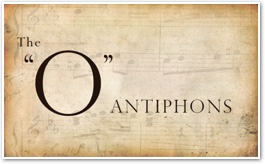One of the things I miss the most from my days in the Monastery is the house’s liturgical rhythm. Each morning, we would rise for the first prayers at 6:30 am. The monks would gather in the chapel, the sun still not up yet, and we would greet the day with prayer. Throughout the rest of the day, there would be other times of prayer and work.
As the seasons changed outside of the Monastery, so did the liturgical seasons inside of the Monastery. As the light faded, the Advent season would begin with its promise of hope, peace, love, and Joy. But within the season of Advent, another shift takes place seven days before the start of the Christmas Season.
These last seven days do not have a name of their own, and for most people, there is no change at all. But starting with Vespers on December 17th, the antiphons used to introduce the Magnificat shift. Each day brings further anticipation of the feast and the revelation of the names or titles of Jesus Christ.
They are called the “O” antiphons because they begin with the vocative particle “O.” Each antiphon is a name of Christ, one of his attributes mentioned in Scripture. They are:
17 December: O Sapientia (O Wisdom)
18 December: O Adonai (O Lord)
19 December: O Radix Jesse (O Root of Jesse)
20 December: O Clavis David (O Key of David)
21 December: O Oriens (O Dayspring)
22 December: O Rex Gentium (O King of the Nations)
23 December: O Emmanuel (O With Us is God)
The exact origin of these antiphons is not known but some trace them as far back as the 4th or 5th century and by the 8th century they are being used as part of liturgical celebrations in Rome.
It would also appear that the arrangement of these antiphons is no mistake. Fr. William Saunders, writing in the Arlington Catholic Herald follows up on this idea that the arrangement of the antiphons was prophetic.
“According to Professor Robert Greenberg of the San Francisco Conservatory of Music, the Benedictine monks arranged these antiphons with a definite purpose. If one starts with the last title and takes the first letter of each one – Emmanuel, Rex, Oriens, Clavis, Radix, Adonai, Sapientia – the Latin words ero cras are formed, meaning, “Tomorrow, I will come“. Therefore, the Lord Jesus, whose coming we have prepared for in Advent and whom we have addressed in these seven Messianic titles, now speaks to us, Tomorrow, I will come. So, the O Antiphons not only bring intensity to our Advent preparation but bring it to a joyful conclusion.”
Over the next seven days I will offer some brief commentary on each of the antiphons. I hope they aid in your preparation for the coming of the great feast of Christmas.

